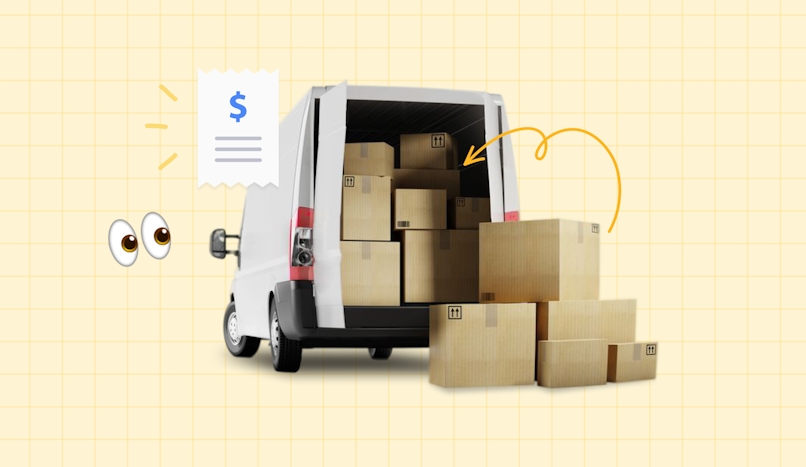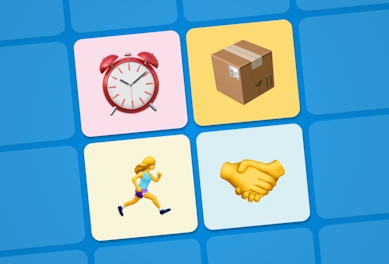Proof of Delivery vs. Bill of Lading: How They Differ
Proof of delivery and bill of lading are common logistics terms to know. This article explains what they mean.

Mastering logistics terms like proof of delivery and bill of lading can simplify your workday. Another way to make your job easier? Circuit for Teams.
If you’re running a warehouse, distribution center, or delivery service, you’ve already heard of proof of delivery and bill of lading. But do you know the difference?
The logistics business is demanding. As a distributor, you know your business might see hundreds (if not thousands) of packages come through in a single day. The last thing you want is for any of those valuable goods to go missing.
There are two valuable documents that can help you track deliveries and protect your liability: proof of delivery (POD) and bill of lading (BOL).
A bill of lading serves as a receipt for freight services. The carrier usually provides one upon pick up. In contrast, proof of delivery is proof that a shipment has arrived and is signed by the final recipient or consignee upon delivery receipt.
Both delivery documents are equally important in the logistics industry, and it’s important that you know when to use which paperwork.
Here, we’ll discuss how the two terms differ along with a quick overview of the documents and their purposes. Then, we’ll give you examples of how they might be used in a real-world workflow.
Let’s look at each one individually and how they work.

What is proof of delivery?
Proof of delivery (POD) gives you evidence that a package has reached its final destination and in the right condition. Why is this important?
Well, in a perfect world, you’d be able to move on to your next delivery without worrying about the package you just delivered. However, the customer may claim they never received their package or that it was damaged or not left where you said it was.
And if you can’t prove the package was delivered, left where you said it was, or that it arrived in pristine condition, it’s basically the customer’s word against yours — possibly tarnishing your business’s reputation.
Plus, you might be liable for any costs associated with the “lost” package or have to redeliver to the customer’s home.
The good news is that POD can save you from a lot of this hassle.
POD can be digital or paper.
A digital proof of delivery (ePOD) might consist of an electronic signature or a photo of a package left at a designated drop-off point. A paper POD could be a piece of paper that your customer signs once they receive their order.
So POD confirms a package’s delivery with a photo or signature, POD. It also gives shipping details, like the recipient’s name and delivery address, a description of where the package was dropped off, and the date and time of delivery.
For example, POD might consist of an e-signature, the customer’s name and address, and a brief summary like, “Package handed to person in the household.”
POD is a valuable tool in the logistics sector, protecting the interests of delivery companies, your drivers, and your customers.
POD lets your customers know their delivery has been fulfilled and gives you peace of mind. It can also minimize the risk of loss or theft.
For example, if the customer instructs the driver to leave a package on their porch, the driver can send a photo POD. With this notification, the customer knows right away that their package has arrived and can bring it inside, reducing the risk of porch piracy.
This improves the customer experience and results in greater customer satisfaction, and greater customer loyalty. The result? More business for your delivery company.
Being able to secure and store POD also protects the liability of delivery companies and their drivers, saving them stress and money. There’s concrete proof that a package has been securely delivered. So no more disputes.
When is proof of delivery used?
Proof of delivery is used to confirm to delivery companies and their customers that a package delivery has been fulfilled.
Here are some examples of how you can use POD.
Let’s say a driver arrives at a customer’s house and hands them a package. They can capture an image to confirm the package’s delivery.
This image can then be recorded and stored within the delivery company’s database Giving assurance that the delivery has been fulfilled. This can protect the company against lost package accusations.
You can also send POD to your customer. This confirms to them that their delivery has arrived safely. This can be especially useful in a multi-person household, where one person might sign for another’s package.
POD can also come in handy if the customer isn’t home.
Let’s say the customer has left a delivery note instructing the driver to leave any packages under the side porch doormat. Your driver can fulfill the order as instructed and take a photo of the package under the mat.
You can then log the photo POD in your main company database and send it to your customer.
The customer can rest easy knowing exactly where to find their package later.
What is a bill of lading?

A bill of lading (BOL) is issued from a carrier to a shipper at a different stage of the logistics journey. It’s a legal document and receipt for shipping services, serving as a contract between the shipper and the carrier.
A BOL details what goods are being transported. Including a description, quantity, and destination. It also includes the terms and conditions for your goods’ transport.
The BOL stays with your shipped products. An authorized representative from the shipping or delivery company must sign off once the goods reach their intended destination.
A BOL can be useful in tracking shipments and preventing theft. This is because it also serves as a document of title, specifying the legal ownership of the products being transported.
Similar to POD, this can help protect the liability and interests of drivers and delivery companies.
Let’s say a truck driver is delivering raw building materials to a construction site. When they leave the supplier, they’ll have a BOL signed by the supplier and driver.
The driver will get a signature confirming receipt on the BOL once they arrive at the construction site and hand over the goods. The recipient can keep a copy, and another copy can be given to the supplier.
This gives you transparency and openness. Your supplier doesn’t have to worry about their driver possibly stealing valuable goods, while the driver doesn’t have to stress about miscommunication leading to such accusations.
When is a bill of lading used?
A bill of lading is used to confirm that goods have safely reached their destination. It also gives you added assurance since it serves as a title and a legally binding contract between the shipper and the carrier that outlines the terms of transport.
Here’s another example of how a BOL can be used to streamline the delivery process.
Let’s say a delivery driver is bringing fresh produce to a restaurant. The restaurant owner has a purchase order specifying that they’re expecting 10 crates of apples, eight crates of oranges, and seven crates of bananas.
Before the driver leaves the produce vendor, they’ll get a BOL specifying what’s in the order. The vendor and the driver will both sign this.
When the driver arrives at the restaurant, the restaurant owner can compare the BOL to their purchase order (PO), ensuring they’re getting what they requested.
Assuming the order is correct, the restaurant owner can then sign off on the BOL, confirming receipt. The restaurant owner can keep a copy and the driver will keep a copy for the vendor.
The food vendor might use the PO and the BOL for invoicing purposes. The vendor can provide the PO and the BOL along with their invoice, providing proof of purchase and receipt.
Proof of delivery vs. bill of lading: Key differences

POD and BOL serve a similar purpose: They confirm the safe delivery of goods to a recipient, protecting delivery companies’ liability. However, they aren’t identical, and it’s important to understand the differences.
The main difference is the context. POD is typical in last-mile delivery (when a package is handed over from a shipping service to an end customer).
A BOL is used for documentation between shippers and carriers. It isn’t necessarily used in last-mile delivery but in earlier supply chain stages. A BOL also tends to be more detailed and may include added info, like a corresponding PO number.
Also, POD isn’t a legally binding contract like a BOL. A BOL includes details like the terms of a shipping agreement, acts as a title proving ownership, and is a legal document.
Discover how Circuit can optimize your shipping business to save you money
Distribution centers, warehouses, and e-commerce retailers are just some business types that can use POD and BOL to improve their proof of delivery management.
Our route management tool is designed to help delivery teams plan and execute their daily routes.
Circuit for Teams started as a route optimization tool, but it has grown to become a route management platform that lets dispatchers plan the fastest routes, track deliveries in real-time, update recipients, and collect photo and electronic signatures for proof of delivery.
If you’re looking for a tool to streamline your delivery processes, give Circuit for Teams a try. Your drivers will have access to two types of electronic proof of delivery (EPOD): signatures and photos.
You can send POD in real time, simplifying your logistics operations and improving the customer experience.
Your drivers can easily access the system through a mobile app, integrating the delivery software so the electronic POD and corresponding delivery information are stored on their device and in your main database.
Finally, Circuit for Teams offers other functionality to enhance your delivery system and improve fleet management, like route optimization, which helps drivers complete their routes faster.





